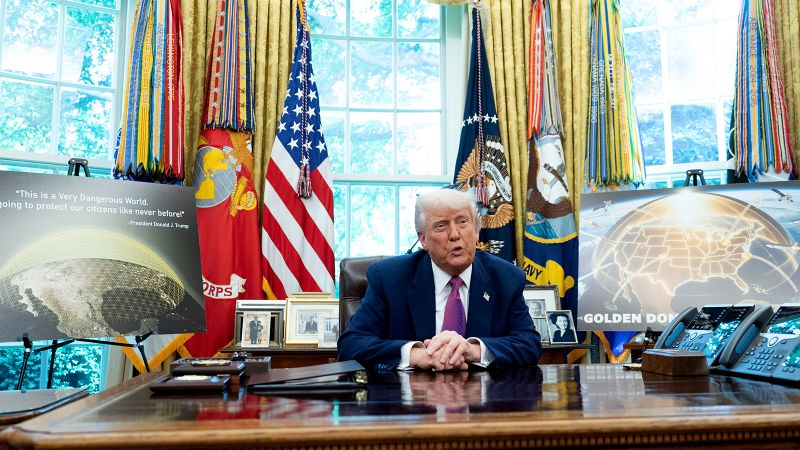In a bold move that has caught the attention of both lawmakers and the public, President Donald Trump has laid out his grand vision for the creation of a sophisticated “Golden Dome” missile defense system designed to safeguard the United States from potential foreign threats. During a press conference held in the Oval Office, Trump expressed optimism about the timeline for this project, asserting that the system is slated for completion within three years. This ambitious undertaking reflects the administration’s broader goal of enhancing national security through innovative technology.
“We’ll have it done in three years,” Trump stated emphatically, underscoring his confidence in the proposal. He elaborated on the capabilities of the proposed Golden Dome, suggesting that it would possess advanced interception technology capable of neutralizing missiles launched from far-off locations around the globe. The system aims to be a formidable barrier against modern threats, particularly given the escalating tensions in international relations, notably with countries like North Korea, Iran, Russia, and China.
High-profile companies in the defense and technology sectors, including the renowned SpaceX founded by entrepreneur Elon Musk, have already shown interest in participating in the project. Various defense contractors are positioning themselves to secure contracts, engaging directly with Defense Secretary Pete Hegseth to make their cases for involvement. However, the specifics of the proposal, such as construction techniques and operational logistics, remain somewhat ambiguous, indicating a more extensive planning process ahead.
Interestingly, the concept for the Golden Dome derives significant inspiration from Israel’s successful Iron Dome system, which has effectively protected populations from short-range missiles. However, there are notable distinctions between the two, particularly regarding the scale and scope of their intended defenses. The Iron Dome is designed to protect an area comparable to New Jersey, while Trump’s Golden Dome is envisioned as a comprehensive space-based defense network capable of covering vast regions more than 450 times larger, equipped to counter advanced types of missiles, including both ballistic and hypersonic threats.
Trump has estimated the budget for this monumental project at approximately $175 billion. Furthermore, the initiative will see leadership from General Michael A. Guetlein, the vice chief of space operations at the United States Space Force, a pivotal position that underscores the project’s emphasis on advanced technology and space capabilities. To fund the initial phases, Trump has indicated that approximately $25 billion will be allocated from his comprehensive tax and spending bill, which is currently a focal point in the negotiations with House Republicans.
In May 2023, the Pentagon presented a series of options to the White House, detailing variations in the scale and functions of the proposed Golden Dome. Despite not revealing a final architecture, Trump noted that a framework for this state-of-the-art defense system has been selected, signaling a step forward in the developmental stages.
However, the administration faces skepticism as its time and cost estimates contradict views from various military officials and experts. Retired Rear Admiral Mark Montgomery has suggested that successful completion of a ballistic missile defense initiative could take 7 to 10 years, emphasizing the potential limitations therein. Other sources claim that the financial requirements could extend into several hundreds of billions of dollars, reflecting the complexities involved in such an expansive undertaking.
Historically, the United States has discussed missile defense projects for many years, yet many of these ambitions have fizzled due to technological challenges and the prohibitive costs associated with such advanced systems. The Defense Intelligence Agency recently emphasized the urgency of this endeavor, highlighting assessments that underscore how foreign adversaries could deploy an array of missile types to target the American mainland.
Executing the Golden Dome will be an incredibly complex task, necessitating a concerted effort from various federal agencies, private contractors, and technological innovators. The process will demand inter-agency cooperation and streamlining to ensure effective implementation and management, given the astute political, military, and logistical challenges expected along the way. As with many visionary projects in governmental undertakings, the success of the “Golden Dome” will ultimately hinge on coordination, strategic funding, and, most notably, public trust in its capabilities and intentions.



